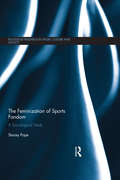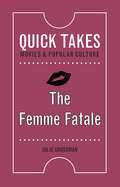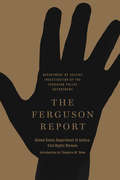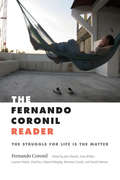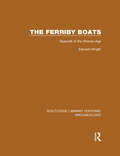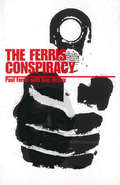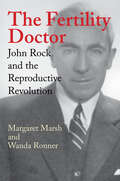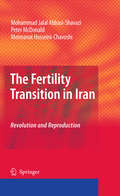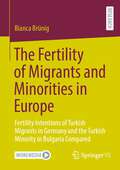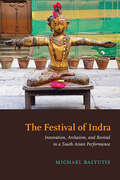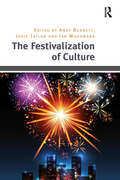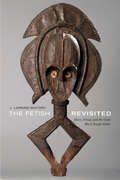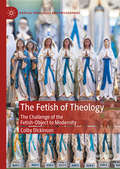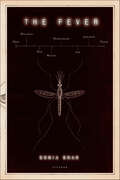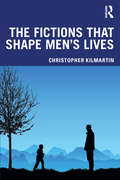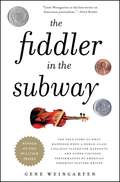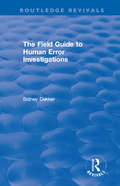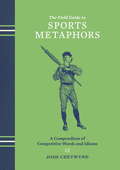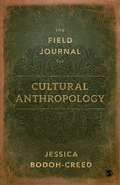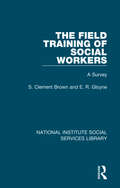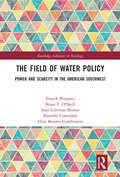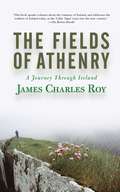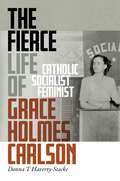- Table View
- List View
The Feminization of Sports Fandom: A Sociological Study (Routledge Research in Sport, Culture and Society)
by Stacey PopeWomen fans have entered the traditionally male domain of the sports stadium in growing numbers in recent years. Watching professional sport is important for women for so many reasons, but their expectations and experiences have been largely ignored by academics. This book tackles these shortcomings in the literature and sheds new light on the many ways in which women become sports fans. This groundbreaking study is the first to focus on the phenomenon of the feminization of sports fandom. Including original research on football and rugby union in the UK, it looks at the increasing opportunities for women to become sports fans in contemporary society and critically examines the way this form of leisure is valued by women. Drawing upon feminist thinking and intersectionality, it shows how women from different social classes and age groups consume the spectacle of sport. This book is fascinating reading for any student or scholar interested in sport and leisure studies, sociology and gender or women’s studies.
The Femme Fatale: Ready For Her Close-up (Quick Takes: Movies and Popular Culture)
by Julie GrossmanOstensibly the villain, but also a model of female power, poise, and intelligence, the femme fatale embodies Hollywood’s contradictory attitudes toward ambitious women. But how has the figure of the femme fatale evolved over time, and to what extent have these changes reflected shifting cultural attitudes toward female independence and sexuality? This book offers readers a concise look at over a century of femmes fatales on both the silver screen and the TV screen. Starting with ethnically exoticized silent film vamps like Theda Bara and Pola Negri, it examines classic film noir femmes fatales like Barbara Stanwyck in Double Indemnity, as well as postmodern revisions of the archetype in films like Basic Instinct and Memento. Finally, it explores how contemporary film and television creators like Fleabag and Killing Eve’s Phoebe Waller-Bridge have appropriated the femme fatale in sympathetic and surprising ways. Analyzing not only the films themselves, but also studio press kits and reviews, The Femme Fatale considers how discourses about the pleasures and dangers of female performance are projected onto the figure of the femme fatale. Ultimately, it is a celebration of how “bad girl” roles have provided some of Hollywood’s most talented actresses opportunities to fully express their on-screen charisma.
The Ferguson Report
by United States Civil Rights Division Theodore M. ShawOn August 9, 2014, Michael Brown, an unarmed African American high school senior, was shot by Officer Darren Wilson in Ferguson, Missouri. For months afterward, protestors took to the streets demanding justice, testifying to the racist and exploitative police department and court system, and connecting the shooting of Brown with the deaths of Trayvon Martin, Eric Garner, and other young black men at the hands of police across the country.In the wake of these protests, the Department of Justice launched a six-month investigation, resulting in a report that Colorlines characterizes as "so caustic it reads like an Onion article" and laying bare what the Huffington Post calls "a totalizing police regime beyond any of Kafka's ghastliest nightmares." Among the report's findings are that the Ferguson Police Department "Engages in a Pattern of Unconstitutional Stops and Arrests in Violation of the Fourth Amendment," "Detain[s] People Without Reasonable Suspicion and Arrest[s] People Without Probable Cause," "Engages in a Pattern of First Amendment Violations," "Engages in a Pattern of Excessive Force," and "Erode[s] Community Trust, Especially Among Ferguson's African-American Residents."Contextualized here in a substantial introduction by renowned legal scholar and former NAACP Legal Defense and Educational Fund president Theodore M. Shaw, The Ferguson Report is a sad, sobering, and important document, providing a snapshot of American law enforcement at the start of the twenty-first century, with resonance far beyond one small town in Missouri.
The Fernando Coronil Reader: The Struggle for Life Is the Matter
by Fernando CoronilIn The Fernando Coronil Reader Venezuelan anthropologist Fernando Coronil challenges us to rethink our approaches to key contemporary epistemological, political, and ethical questions. Consisting of work written between 1991 and 2011, this posthumously published collection includes Coronil's landmark essays “Beyond Occidentalism” and “The Future in Question” as well as two chapters from his unfinished book manuscript, "Crude Matters." Taken together, the essays highlight his deep concern with the Global South, Latin American state formation, theories of nature, empire, and postcolonialism, and anthrohistory as an intellectual and ethical approach. Presenting a cross section of Coronil's oeuvre, this volume cements his legacy as one of the most innovative critical social thinkers of his generation.
The Ferriby Boats: Seacraft of the Bronze Age (Routledge Library Editions: Archaeology #No. 23)
by Edward WrightIn 1937 the author, then aged 19, found the remains of an ancient boat at Ferriby on the Humber shore. This book is his own account of his discoveries, excavations and research over 50 years since the first boat find. The importance of this and the subsequent finds was only fully recognised after World War II, when the new technique of carbon-14 dating revealed that the Ferriby Boats were built before 1000 BC. This makes them the oldest plank-built boats found anywhere in the world apart from Ancient Egypt and the Aegean; they predate any similar craft in Northern Europe by half a millennium and present evidence for a style of boat building previously unknown. The excavation and preservation of the boats presented many problems, not least the constant battle with mud and the tide. Over the years the author pioneered methods of excavating and recording which have since become standard in the field of maritime archaeology. This book also presents a realistic reconstruction of the boats with estimates of its performance. They suggest a capacity for navigation at this time not previously imagined and add a new and fundamental dimension to the history of man's relationship with the sea.
The Ferris Conspiracy
by Paul Ferris Reg McKayOn Glasgow's meanest streets life started well for the young Paul Ferris. How did he become Glasgow's most feared gangster, deemed a risk to national security?Arthur Thompson, Godfather of the crime world and senior partner of the Krays, recruited young Ferris as a bagman, debt collector and equaliser. Feared for his capacity for extreme violence, respected for his intelligence, Ferris was the Godfather's heir apparent. But when gang warfare broke, underworld leaders traded in flesh, colluding with their partners - the police. Disgusted, Ferris left the Godfather and stood alone. They gave him weeks to live.While Ferris was caged in Barlinnie Prison's segregation unit accused of murdering Thompson's son, Fatboy, his two friends were shot dead the night before the funeral and grotesquely displayed in a car on the cortége's route. Acquitted against all the odds, Ferris moved on, determined to make an honest living.They would not let him.The National Crime Squad, MI5, the police and two of the country's most powerful gangsters saw to that. A maximum-security prisoner, Ferris is known as 'Lucky' because he is still alive.This is one man's unique insight into Britain's crime world and the inextricable web of corruption - a revealing story of official corruption and unholy alliances.
The Fertility Doctor: John Rock and the Reproductive Revolution
by Margaret Marsh Wanda RonnerAs Louise Brown—the first baby conceived by in vitro fertilization—celebrates her 30th birthday, Margaret Marsh and Wanda Ronner tell the fascinating story of the man who first showed that human in vitro fertilization was possible.John Rock spent his career studying human reproduction. The first researcher to fertilize a human egg in vitro in the 1940s, he became the nation’s leading figure in the treatment of infertility, his clinic serving rich and poor alike. In the 1950s he joined forces with Gregory Pincus to develop oral contraceptives and in the 1960s enjoyed international celebrity for his promotion of the pill and his campaign to persuade the Catholic Church to accept it. Rock became a more controversial figure by the 1970s, as conservative Christians argued that his embryo studies were immoral and feminist activists contended that he had taken advantage of the clinic patients who had participated in these studies as research subjects. Marsh and Ronner’s nuanced account sheds light on the man behind the brilliant career. They tell the story of a directionless young man, a saloon keeper’s son, who began his working life as a timekeeper on a Guatemalan banana plantation and later became one of the most recognized figures of the twentieth century. They portray his medical practice from the perspective of his patients, who ranged from the wives of laborers to Hollywood film stars.The first scholars to have access to Rock’s personal papers, Marsh and Ronner offer a compelling look at a man whose work defined the reproductive revolution, with its dual developments in contraception and technologically assisted conception.
The Fertility Transition in Iran
by Meimanat Hosseini-Chavoshi Mohammad Jalal Abbasi-Shavazi Peter McdonaldConfounding all conventional wisdom, the fertility rate in the Islamic Republic of Iran fell from around 7.0 births per woman in the early 1980s to 1.9 births per woman in 2006. That this, the largest and fastest fall in fertility ever recorded, should have occurred in one of the world's few Islamic Republics demands explanation. This book, based upon a decade of research is the first to attempt such an explanation. The book documents the progress of the fertility decline and displays its association with social and economic characteristics. It addresses an explanation of the phenomenal fall of fertility in this Islamic context by considering the relevance of standard theories of fertility transition. The book is rich in data as well as the application of different demographic methods to interpret the data. All the available national demographic data are used in addition to two major surveys conducted by the authors. Demographic description is preceded by a socio-political history of Iran in recent decades, providing a context for the demographic changes. The authors conclude with their views on the importance of specific socio-economic and political changes to the demographic transition. Their concluding arguments suggest continued low fertility in Iran. The book is recommended to not only demographers, social scientists, and gender specialists, but also to policy makers and those who are interested in social and demographic changes in Iran and other Islamic countries in the Middle East. It is also a useful reference for demography students and researchers who are interested in applying fertility theories in designing surveys and analysing data.
The Fertility of Migrants and Minorities in Europe: Fertility Intentions of Turkish Migrants in Germany and the Turkish Minority in Bulgaria Compared
by Bianca BrünigThis book analyses the relationship between assimilation and fertility intentions for migrants and minorities in Europe. Building upon assimilation theory, it is argued that both migrants and minorities assimilate in the process of intercultural encounters. Given that fertility is part of the cultural dimension of assimilation, it is likely to be influenced by assimilation. Therefore, theories on assimilation and fertility are merged theoretically as well as empirically. Using data from the Generations and Gender Survey, the empirical section builds upon a comparison of Turkish migrants in Germany and the Turkish minority in Bulgaria. Building upon cluster analyses, six clusters within Germany as well as five clusters in Bulgaria are developed to account for heterogeneity of groups. Comparing these clusters in terms of assimilation and fertility intentions it becomes clear that the Turkish minority does not differ in their fertility intentions from the majority. For Germany, Turkish migrants differ from German natives regarding their fertility intentions, but differences are explained by assimilation, especially structural characteristics. When comparing migrant and minority, differences in fertility exist and are accounted for by cultural dissimilarity.
The Festival Cities of Edinburgh and Adelaide
by Sarah ThomassonThe Festival Cities of Edinburgh and Adelaide examines how these cities’ world-famous arts events have shaped and been shaped by their long-term interaction with their urban environments. While the Edinburgh International Festival and Adelaide Festival are long-established, prestigious events that champion artistic excellence, they are also accompanied by the two largest open-access fringe festivals in the world. It is this simultaneous staging of multiple events within Edinburgh’s Summer Festivals and Adelaide’s Mad March that generates the visibility and festive atmosphere popularly associated with both places. Drawing on perspectives from theatre studies and cultural geography, this book interrogates how the Festival City, as a place myth, has developed in the very different local contexts of Edinburgh and Adelaide, and how it is challenged by groups competing for the right to use and define public space. Each chapter examines a recent performative event in which festival debates and controversies spilled out beyond the festival space to activate the public sphere by intersecting with broader concerns and audiences. This book forges an interdisciplinary, comparative framework for festival studies to interrogate how festivals are embedded in the social and political fabric of cities and to assess the cultural impact of the festivalisation phenomenon.
The Festival of Indra: Innovation, Archaism, and Revival in a South Asian Performance (SUNY series in Hindu Studies)
by Michael BaltutisThe Festival of Indra details the textual and performative history of an important South Asian festival and its role in the development of classical Hinduism. Drawing on various genres of Sanskrit textual sources—especially the epic Mahābhārata—the book highlights the innovative ways that this annual public festival has supported the stable royal power responsible for the sponsorship of these texts. More than just a textual project, however, the book devotes significant ethnographic attention to the only contemporary performance of this festival that adheres to the classical Sanskrit record: the Indrajatra of Kathmandu, Nepal. Here, Indra's tall pole remains the festival's focal point, though its addition of the royal blessing by Kumari, the "living goddess" of Nepal, and the regular presence of the fierce god Bhairav show several significant ways that ritual agents have re-constructed this festival over the past two thousand years.
The Festivalization of Culture
by Jodie TaylorThe Festivalization of Culture explores the links between various local and global cultures, communities, identities and lifestyle narratives as they are both constructed and experienced in the festival context. Drawing on a wide range of case studies from Australia and Europe, festivals are examined as sites for the performance and critique of lifestyle, identity and cultural politics; as vehicles for the mobilization and cementation of local and global communities; and as spatio-temporal events that inspire and determine meaning in people's lives. Investigating the manner in which festivals are no longer merely periodic, cultural, religious or historical events within communities, but rather a popular means through which citizens consume and experience culture, this book also sheds light on the increasing diversity of contemporary societies and the role played by festivals as sites of cohesion, cultural critique and social mobility. As such, this book will be of interest to those working in areas such as the sociology, consumption and commodification of culture, social and cultural geography, anthropology, cultural studies and popular music studies.
The Fetish Revisited: Marx, Freud, and the Gods Black People Make
by J. Lorand MatorySince the early-modern encounter between African and European merchants on the Guinea Coast, European social critics have invoked African gods as metaphors for misplaced value and agency, using the term “fetishism” chiefly to assert the irrationality of their fellow Europeans. Yet, as J. Lorand Matory demonstrates in The Fetish Revisited, Afro-Atlantic gods have a materially embodied social logic of their own, which is no less rational than the social theories of Marx and Freud. Drawing on thirty-six years of fieldwork in Africa, Europe, and the Americas, Matory casts an Afro-Atlantic eye on European theory to show how Marx’s and Freud’s conceptions of the fetish both illuminate and misrepresent Africa’s human-made gods. Through this analysis, the priests, practices, and spirited things of four major Afro-Atlantic religions simultaneously call attention to the culture-specific, materially conditioned, physically embodied, and indeed fetishistic nature of Marx’s and Freud’s theories themselves. Challenging long-held assumptions about the nature of gods and theories, Matory offers a novel perspective on the social roots of these tandem African and European understandings of collective action, while illuminating the relationship of European social theory to the racism suffered by Africans and assimilated Jews alike.
The Fetish of Theology: The Challenge of the Fetish-Object to Modernity (Radical Theologies and Philosophies)
by Colby DickinsonBy delving into the history of the fetish-object among both modern and contemporary commentators, this book highlights the fetish-object’s role as a philosophical and religious concept of the highest significance. Historically, fetishes are implicated in specific struggles for sovereign (political) and/or religious (hierarchical) power, with their interwoven symbols defined as the primary location for transcendence in our world. This book defines the political consequences of fetish-objects within a western cultural, and primarily theological context through a comparative approach of various literatures on fetish-objects—anthropological to the psychological, Marxist to the theological. It reconceives of fetishes as a form of resistance to oppressive structures, something which motivated Christians themselves historically, and shaped our western understanding of the sacraments far more than has been acknowledged. Taking up this conversation likewise holds forth the possibility of reconceptualizing how fetish-objects and sacramental presences both speak profoundly to our late-modern selves.
The Fever: How Malaria Has Ruled Humankind for 500,000 Years
by Sonia ShahThis deep dive into humanity’s very long fight against malaria is “a vivid and compelling history with a message that’s entirely relevant today” (Elizabeth Kolbert, Pulitzer Prize–winning author of The Sixth Extinction).In a time when every emergent disease inspires waves of panic, why aren’t we doing more to eradicate one of our oldest foes? And how does a parasitic disease that we’ve known how to prevent for more than a century still infect 500 million people every year, killing nearly 1 million of them? Philanthropists from Laura Bush to Bono to Bill Gates have contributed to the effort to find a cure for malaria—but there’s much more that can be done to minimize its deadly effects.In The Fever, journalist Sonia Shah sets out to answer these questions, delivering a timely, inquisitive chronicle of the illness and its influence on human lives. Through the centuries, she finds, we’ve invested our hopes in a panoply of drugs and technologies, and invariably those hopes have been dashed. From the settling of the New World to the construction of the Panama Canal, through wars and the advances of the Industrial Revolution, Shah tracks malaria’s jagged ascent and the tragedies in its wake, revealing a parasite every bit as persistent as the insects that carry it. With distinguished prose and original reporting from Panama, Malawi, Cameroon, India, and elsewhere, The Fever captures the curiously fascinating, devastating history of this long-standing thorn in the side of humanity.“Fascinating . . . an absorbing account of human ingenuity and progress, and of their heartbreaking limitations.” —Publishers Weekly“A thrilling detective story, spanning centuries, about our erratic pursuit of a villain still at large . . . rich in colorful detail.” —Malcolm Molyneux, Professor, Liverpool School of Tropical Medicine
The Fictions that Shape Men's Lives
by Christopher KilmartinThe Fictions that Shape Men’s Lives is structured around a number of key ‘fictions’ of masculinity, such as beliefs in biological determinism, the inevitability of men’s violence and the opposition of the sexes, and proceeds to expose them to be wholly or partially unfounded. Examining the social pressure to behave and experience the self in ways that culture prescribes for the bodies we are perceived as having, this book provides an awareness of widely-held but distorted assumptions of gender. It also seeks to put men into the position to resist masculine social pressures when conforming to it conflicts with important life goals or values and/or causes harm. Making use of an informal, storytelling style provides an accessibility to those interested in breaking down their preconceptions of gender and masculinity, as well making links to key theories and concepts. This is a lively and engaging book for undergraduates studying introduction to Gender, Sexuality and Masculinity courses.
The Fiddler in the Subway
by Gene WeingartenGENE WEINGARTEN IS THE O. HENRY OF AMERICAN JOURNALISM Simply the best storyteller around, Weingarten describes the world as you think it is before revealing how it actually is--in narratives that are by turns hilarious, heartwarming, and provocative, but always memorable. Millions of people know the title piece about violinist Joshua Bell, which originally began as a stunt: What would happen if you put a world-class musician outside a Washington, D.C., subway station to play for spare change? Would anyone even notice? The answer was no. Weingarten's story went viral, becoming a widely referenced lesson about life lived too quickly. Other classic stories--the one about "The Great Zucchini," a wildly popular but personally flawed children's entertainer; the search for the official "Armpit of America"; a profile of the typical American nonvoter--all of them reveal as much about their readers as they do their subjects.
The Field Guide to Human Error Investigations (Routledge Revivals)
by Sidney DekkerThis title was first published in 2002: This field guide assesses two views of human error - the old view, in which human error becomes the cause of an incident or accident, or the new view, in which human error is merely a symptom of deeper trouble within the system. The two parts of this guide concentrate on each view, leading towards an appreciation of the new view, in which human error is the starting point of an investigation, rather than its conclusion. The second part of this guide focuses on the circumstances which unfold around people, which causes their assessments and actions to change accordingly. It shows how to "reverse engineer" human error, which, like any other componant, needs to be put back together in a mishap investigation.
The Field Guide to Sports Metaphors: A Compendium of Competitive Words and Idioms
by Josh ChetwyndA gift-worthy playbook of common and unexpected words and idioms that have their roots in sports and games. There are many metaphors we can quickly identify from the realm of sports: covering all the bases (baseball), game plan (football), and par for the course (golf). But the English language is also peppered with the not-so-obvious influence of sports and games, such as go-to guy (basketball) and dead ringer (horse racing). Filled with pithy entries on each idiom, plus quotes showing how big talkers from President Obama to rapper Ice-T use them, this quirky little handbook from former minor league ballplayer and award-winning journalist Josh Chetwynd is sure to be a conversation starter at tailgates, cocktail parties, and in the boardroom.From the Hardcover edition.
The Field Journal for Cultural Anthropology
by Dr. Jessica Bodoh-CreedThink about the world around you in new and different ways! The Field Journal for Cultural Anthropology takes students on an active journey of activities and research in order to apply the concepts they learn in the classroom. With over a decade's worth of teaching and researching in anthropology, author Jessica Bodoh-Creed’s interactive book prompts students to practice fieldwork and ethnographic skills such as interviewing, taking field notes, creating maps and kinship charts, and overall gathering of data to become effective researchers. The topics cover the gamut of traditional cultural anthropology making this field journal relatable and engaging for students of all ages and backgrounds.
The Field Journal for Cultural Anthropology
by Dr. Jessica Bodoh-CreedThink about the world around you in new and different ways! The Field Journal for Cultural Anthropology takes students on an active journey of activities and research in order to apply the concepts they learn in the classroom. With over a decade's worth of teaching and researching in anthropology, author Jessica Bodoh-Creed’s interactive book prompts students to practice fieldwork and ethnographic skills such as interviewing, taking field notes, creating maps and kinship charts, and overall gathering of data to become effective researchers. The topics cover the gamut of traditional cultural anthropology making this field journal relatable and engaging for students of all ages and backgrounds.
The Field Training of Social Workers: A Survey (National Institute Social Services Library)
by S. Clement Brown E. R. GloyneFirst published in 1966, the original blurb read: Learning with the help of skilled practitioners is as essential in training for social work as for medicine and teaching. Where do students of social work go for field training and why? What is it hoped that they will learn through their experience? What responsibilities are they given and who guides their learning? Partnership between social workers and academic staff in working out these questions is considered at a critical time in the changing perspectives and expansion of social services. The staff of colleges and social agencies, students, and professional organizations have helped to produce the facts and views on which this survey is based.
The Field of Water Policy: Power and Scarcity in the American Southwest (Routledge Advances in Sociology)
by Franck Poupeau Brian F. O'Neill Joan Cortinas Muñoz Murielle Coeurdray Eliza Benites-GambirazioBringing together the analysis of a diverse team of social scientists, this book proposes a new approach to environmental problems. Cutting through the fragmented perspectives on water crises, it seeks to shift the analytic perspectives on water policy by looking at the social logics behind environmental issues. Most importantly, it analyzes the dynamic influences on water management, as well as the social and institutional forces that orient water and conservation policies. The first work of its kind, The Field of Water Policy: Power and Scarcity in the American Southwest brings the tools of Pierre Bourdieu’s field sociology to bear on a moment of environmental crisis, with a study of the logics of water policy in the American Southwest, a region that allows us to see the contest over the management of scarce resources in a context of lasting drought. As such, it will appeal to scholars in the social and political sciences with interests in the environment and the management of natural resources.
The Fields of Athenry: A Journey Through Ireland
by James Charles RoyIn The Fields of Athenry, James Charles Roy leads us through the Irish past and present by way of his own personal struggles and misadventures in renovating Moyode Castle, an old tower house that he purchased more than thirty years ago. While he pieces together its four-hundred-year-old past, the castle becomes a powerful symbol for Roy - it is battered by waves of history, yet timeless and resilient. Roy’s personal struggles with the land and its people open for him a wide-ranging historical conversation on Ireland today and our sense of history more broadly. How do we reconcile the historical nostalgia attached to Ireland with the boom times that the "Celtic Tiger" enjoys today? With this question in mind, Roy searches for the answer of what attracts us - or, perhaps more aptly, him - to the rubble of a castle from Irish days long past.
The Fierce Life of Grace Holmes Carlson: Catholic, Socialist, Feminist
by Donna T. Haverty-StackeShares the story of the revolutionary Marxist and Catholic Grace Holmes Carlson and her life-long dedication to challenging social and economic inequalityOn December 8, 1941, Grace Holmes Carlson, the only female defendant among eighteen Trotskyists convicted under the Smith Act, was sentenced to sixteen months in federal prison for advocating the violent overthrow of the government. After serving a year in Alderson prison, Carlson returned to her work as an organizer for the Socialist Workers Party (SWP) and ran for vice president of the United States under its banner in 1948. Then, in 1952, she abruptly left the SWP and returned to the Catholic Church. With the support of the Sisters of St. Joseph, who had educated her as a child, Carlson began a new life as a professor of psychology at St. Mary’s Junior College in Minneapolis where she advocated for social justice, now as a Catholic Marxist.The Fierce Life of Grace Holmes Carlson: Catholic, Socialist, Feminist is a historical biography that examines the story of this complicated woman in the context of her times with a specific focus on her experiences as a member of the working class, as a Catholic, and as a woman. Her story illuminates the workings of class identity within the context of various influences over the course of a lifespan. It contributes to recent historical scholarship exploring the importance of faith in workers’ lives and politics. And it uncovers both the possibilities and limitations for working-class and revolutionary Marxist women in the period between the first and second wave feminist movements. The long arc of Carlson’s life (1906–1992) ultimately reveals significant continuities in her political consciousness that transcended the shifts in her particular partisan commitments, most notably her life-long dedication to challenging the root causes of social and economic inequality. In that struggle, Carlson ultimately proved herself to be a truly fierce woman.
